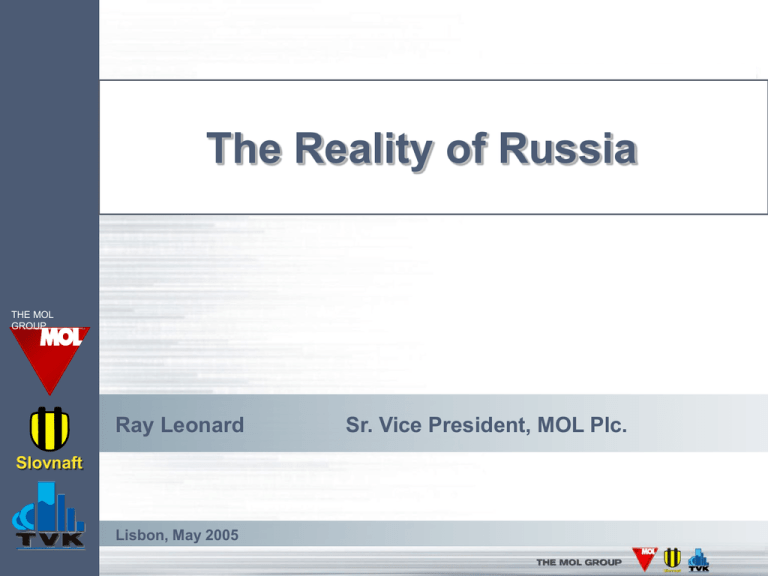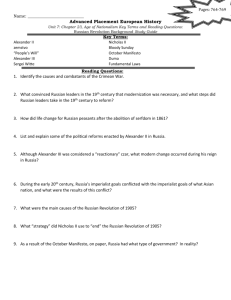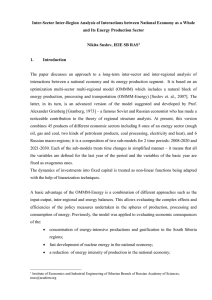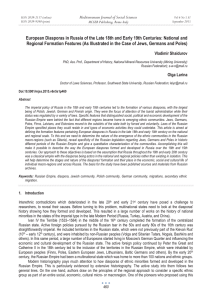Russian Oil Production Outlook
advertisement

The Reality of Russia THE MOL GROUP Ray Leonard Slovnaft Lisbon, May 2005 Sr. Vice President, MOL Plc. Russia has entered a new era ► 1980’s: Soviet Empire with 20% of world oil production ► 1990-1998: Collapse and reorganization as production drops from 12 to 6 MMBO/D ► 1999-2004: Industry revival in Russia with production increase to 9 MMBO/D ► 2005-?: State re-asserts control and production stabilizes ►1 Russian Reserves Two sets of calculations: Russian C1(proven) accurately measures reserves without economic filter while SPE and SEC measure economically recoverable reserves and actual developed reserves 90 80 70 60 50 C1 Russian reserves are 119 billion barrels 20 10 Russia Shelf E Siberia Timan Pechora 0 Volga Urals Proven reserves are concentrated in West Siberia with about 70% in difficult to produce reservoirs 30 W Siberia As development of past five years has taken place, gap between SPE and SEC numbers and C1 is narrowing 40 Proven Reserve BB ►2 Exploration Potential Minimal exploration took place in 1999-2004 period 14 Lack of guaranteed production rights if discovery is made 12 Far lower cost to increase production in discovered fields 8 Fiscal terms not encouraging for upfront capital intensive projects 4 10 6 2 RS ES TP VU Large portion of future risked potential of 43 billion barrels is in more costly areas WS 0 Risked Expl Reserves BB ►3 Infrastructure Limitation of production increase in 1999-2004 period was pipeline access With production flat or slightly declining, this is no longer a problem Combination of export tariff (now $120/ton) and high rail transportation costs have made rail export unattractive economically ►4 Rising Costs (Eskin 2004) Part of the reason for 19992004 boom was ruble devaluation Ruble appreciation is taking away that benefit 2 1,8 1,6 1,4 1,2 1 In the coming years, production will shift to tighter reservoirs in West Siberia and frontier areas with high costs 0,8 0,6 0,4 0,2 2005-8 W Sib wells $MM 2004 2000 1999 1998 0 V Urals wells $MM ►5 Rising Costs (continued) Eskin 2004 4,5 14 4 12 3,5 10 3 2,5 8 2 6 1,5 4 1 RS ES TP VU Lifting Costs WS and VU $/bbl W Sib 2005-8 2004 0 2000 0 1999 2 1998 0,5 Capex per new unit prod $/bbl ►6 Investment 2005-2010 Investment will not increase despite high oil prices during the 2005-10 period Export tariffs and other taxes remove 90% of value of oil above $25/bbl Russian investment laws remain unfriendly to long-term high front end cost projects Limited number of projects for foreign investors to operate For this period, Russian companies will use available capital to cover rising costs and pay taxes ►7 Future Investment Shift from mature to frontier regions will require greater investment after 2008 80 60 40 20 Under current tax regime, these funds will have to be borrowed -20 -40 2016-20 2011-15 -60 2005-10 If funds are not available, production will drop 0 Investment $BB Tax collected Cash flow ►8 Russian Oil Production and Exports 10 9 8 7 6 5 4 3 2 1 0 2000 2005 2010 Oil production MMBO/D 2015 2020 Crude exports MMBO/D ►9 Conclusions Current Russian policies have ended period of production growth With production flat or slightly declining, no new pipelines are needed, although East Siberia line may be built for political reasons, reducing exports to Europe State has assumed control of industry with limited opportunities for foreign investment Russia will be able to use industry as cash generator for next five years as lower cost areas are produced Crisis will come at the end of decade when lack of investment during 2005-10 needed to maintain future level of production by development of new areas becomes apparent, unless current policies are changed ► 10











